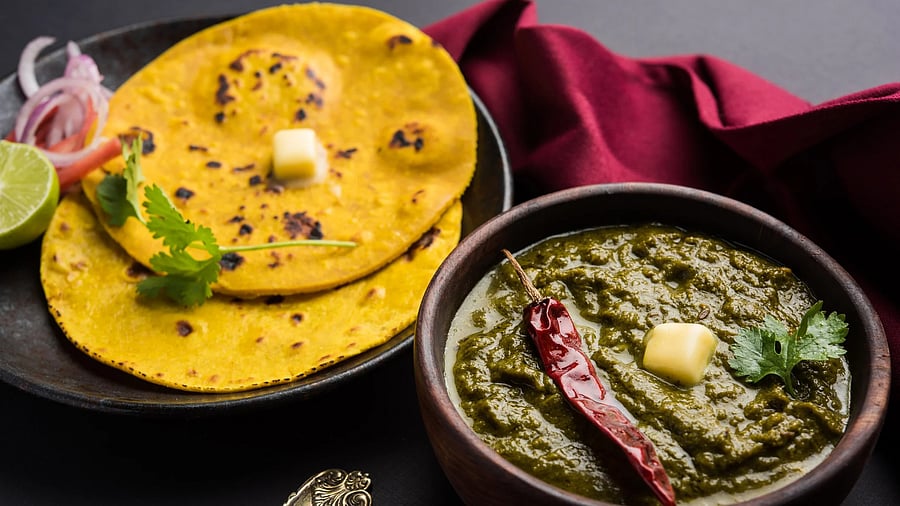
Sarson da Saag with Makki ki roti.
Credit: iStock Photo
Forty-eight hours means no more than four big meals, which is hardly enough time to do justice to a city famed for its cuisine. True, there are several cities celebrated for their food, but we’d wager that only one is renowned worldwide for its largest free kitchen. That city is Amritsar.
Most people associate the city with Amritsari fish and Tandoori chicken. But surprise! Our choice of a hotel right next to the Golden Temple turned our trip into a vegetarian odyssey — the eateries around the sacred precinct serve only vegetarian food. So, farewell to the non-veg trail. But as a friend often reminds us, “Hey, veg is also food, ok?” And what vegetarian delights does Amritsar have to offer!
The city spoils you with countless dhabas and restaurants. Our task was easier thanks to a friend who had recently visited and recommended a few tried-and-tested places. For our first lunch, we landed at Bade Bhai ka Brothers’ Dhaba, an unusual spot where more women than men were serving food. “This should be Sisters Dhaba!” I, as a woman, quipped, drawing laughter from those around. A cheeky sign inside proclaimed that Punjabis have a “Blood group: Ghee positive.” And with good reason. What else but a steaming hot Sarson da Saag, crowned with a generous dollop of butter, should one order for a first meal in Punjab? Paired with the traditional Makki di Roti, it was as heavenly as expected.
For variety, we asked our server for a substitute for the second roti. She recommended a Garlic Mirchi Paratha. At first, we hesitated — wouldn’t garlic overwhelm the subtle saag? But the pairing was perfect. A tall glass of salty Chaach (buttermilk) completed the meal, making it both filling and refreshing.
No trip to Amritsar is complete without its famous kulcha. Be warned, it’s a full meal by itself. Thankfully, we could share one stuffed kulcha, accompanied by cooling dahi and tangy pickle. Dinner that evening was at Bharawan da Dhaba, right next door to Brothers'. Here, we relished a plate of Rajma Chawal — made with authentic Punjabi rajma, not the heavily masala-laden versions one often encounters elsewhere. Simple, hearty, and brimming with flavour, it lets the ‘pulse’ of rajma shine. To end on a sweet note, we dug into Matka Kulfi, creamy and cold in an earthen pot. And because no meal in Punjab feels complete without chai, we capped the evening with steaming masala tea from a tiny roadside joint.
Punjab, of course, is never short on mithai. We picked up Pinni, Pateesa (soan papdi), and Phirni from Goenka Sweets, packing them to enjoy later. Wanting a taste of Punjab to take home, we also shopped for local masalas like raita masala and paratha masala, along with wariyans, advertised all over the city.
And then there was the lassi. We had heard the local joke: “If you must drink and drive, drink lassi.” The wisdom of this became clear when our lassi arrived in a towering glass — the only size available, it seemed. Served with a spoon, not a straw, we were puzzled at first. But we soon realised why. The glass came topped with a thick, creamy layer that had to be scooped off and eaten before sipping the liquid beneath. One lassi was enough to fill us up for hours.
But remember the “free food” we mentioned? For that, we headed to the Golden Temple itself. Yes, you guessed it — it was langar time. In fact, at the Golden Temple, every hour is langar time.
The world’s largest free kitchen serves over 50,000 meals a day, almost entirely powered by volunteer work — a living embodiment of the Sikh philosophy of sewa (selfless service). If there’s just one meal you have in Amritsar, it must be the Guru ka Langar. The Golden Temple and the Sikh community are known for many things, but none as universally cherished as this. Everyone — regardless of caste, creed, religion, or belief — is warmly welcomed into the vast dining hall.
The food itself is not fancy, but its soul is unmatched. Abou Ben Adhem, who loved his fellow man, would have approved — for the meal is served with humility, love, and a rare spirit of equality. The spread is simple: roti, dal, rice, and a vegetable. On the day we visited, the rotis were ready before the vegetables, so we tucked into roti, dal, and rice. Later, kheer was served, sweet and soothing. Water came from an unusual contraption — a large urn on wheels rolled down the rows of diners. And before leaving, we received Karah Prasad, the atta-based blessing unique to gurudwaras.
What struck us most was that, without any signs instructing diners, not a single plate had leftover food. Everyone ate everything they were served. No wastage, just gratitude. Truly, food for thought.
In 48 hours, Amritsar had fed not just our stomachs but also our souls. And while four meals barely scratched the surface of its culinary wealth, what we tasted will remain unforgettable.